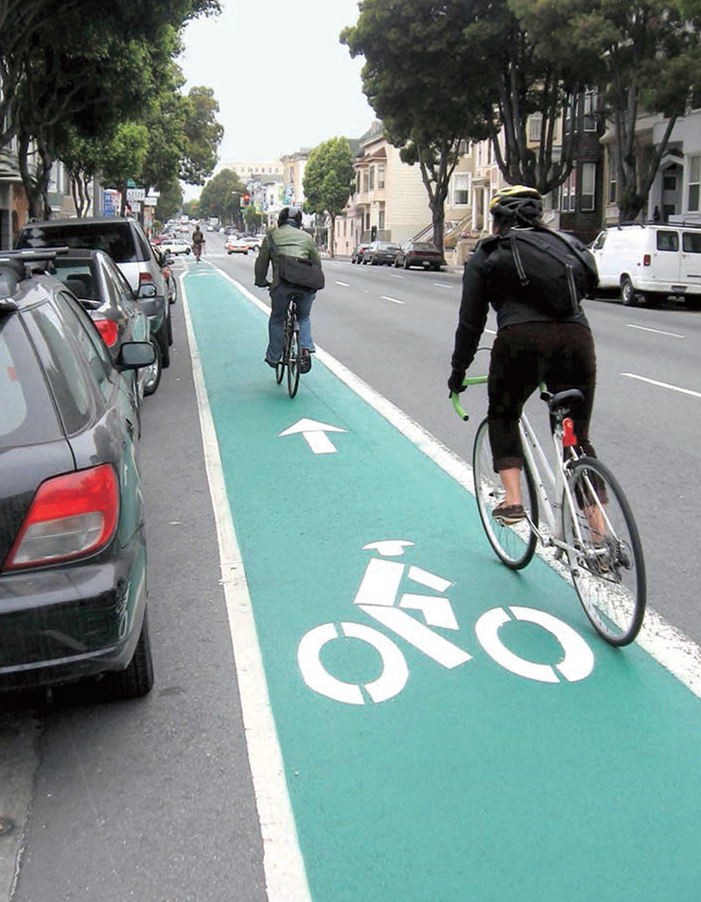
Left-Side Bike Lanes

SAN FRANCISCO, CA
Left-side bike lanes are conventional bike lanes placed on the left side of one-way streets or two-way median divided streets.
Left-side bike lanes offer advantages along streets with heavy delivery or transit use, frequent parking turnover on the right side, or other potential conflicts that could be associated with right-side bicycle lanes. The reduced frequency of right-side door openings lowers dooring risk.

NEW YORK, NY
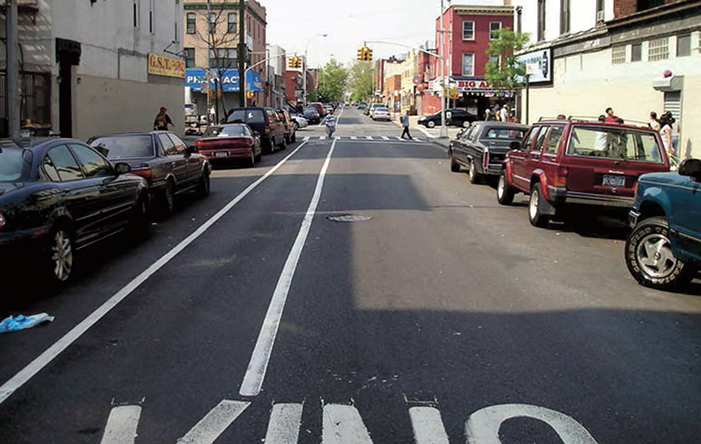
NEW YORK, NY
Benefits
Avoids potential right-side bike lane conflicts on streets.
Improves bicyclist visibility by motorists by having the bike lane on the driver’s side.
Provides consistent facility configuration in locations where right-side travel lanes are subject to rush hour parking restrictions and other flexible uses.
Minimizes door zone conflicts next to parking because of fewer door openings on the passenger side of vehicles.
Fewer bus and truck conflicts as most bus stops and loading zones are on the right side of the street.
Typical Applications
On one-way streets or median divided streets with frequent bus stops or truck loading zones on the right side of the street.
On streets with high parking turnover.
On streets with rush hour parking restrictions.
On streets with high volumes of right turn movements by motor vehicles.
On streets with a significant number of left-turning bicyclists.
On streets where traffic enters into an add lane on the right-hand side, as from a freeway off-ramp.
For favorable alignment to connect to a path, two-way cycle track, or other bicycle facility.
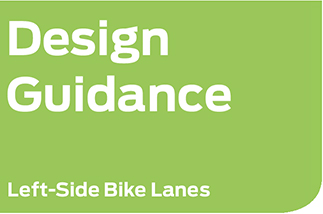

Required Features
 Design guidance for conventional bike lanes applies to this treatment.
Design guidance for conventional bike lanes applies to this treatment.
 Left side bike lanes shall only be placed on the left side of one-way streets or two-way median divided streets.
Left side bike lanes shall only be placed on the left side of one-way streets or two-way median divided streets.
Recommended Features
 Signage should accompany left-side bicycle lanes to clarify proper use by bicyclists and may be effective in reducing wrong-way riding. Modified MUTCD R3 series sign shown.
Signage should accompany left-side bicycle lanes to clarify proper use by bicyclists and may be effective in reducing wrong-way riding. Modified MUTCD R3 series sign shown.
 Bicycle through lanes should be provided to the right of vehicle left turn pockets to reduce conflicts at intersections. This is important for through bicyclists as well as left turning bicyclists as left turning vehicles will cross paths with a left turning bicyclist. Additional guidance can be found in through bicycle lanes in this guide.
Bicycle through lanes should be provided to the right of vehicle left turn pockets to reduce conflicts at intersections. This is important for through bicyclists as well as left turning bicyclists as left turning vehicles will cross paths with a left turning bicyclist. Additional guidance can be found in through bicycle lanes in this guide.
 Where bicyclist demand is high and street space permits, a buffered bike lane configuration or wider than minimum dimensions should be used to allow bicyclists to pass one another without encroaching upon the adjacent travel lane.
Where bicyclist demand is high and street space permits, a buffered bike lane configuration or wider than minimum dimensions should be used to allow bicyclists to pass one another without encroaching upon the adjacent travel lane.
 Intersection treatments such as bike boxes and bike signals, should be considered to assist in the transition from left-side bike lanes to right-side bike lanes.
Intersection treatments such as bike boxes and bike signals, should be considered to assist in the transition from left-side bike lanes to right-side bike lanes.
 A “Yield to Bikes” sign should be post-mounted in advance of and in conjunction with a left turn lane to reinforce that bicyclists have the right-of-way going through the intersection.15
A “Yield to Bikes” sign should be post-mounted in advance of and in conjunction with a left turn lane to reinforce that bicyclists have the right-of-way going through the intersection.15
Optional Features
 Colored pavement may be used along the facility to draw attention to the unique function of the lane, or within conflict areas for increased visibility of bicyclists.
Colored pavement may be used along the facility to draw attention to the unique function of the lane, or within conflict areas for increased visibility of bicyclists.
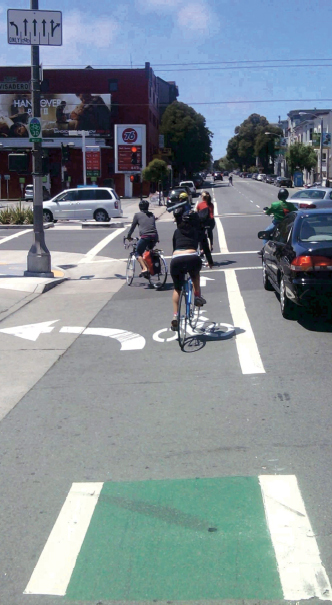
SAN FRANCISCO , CA
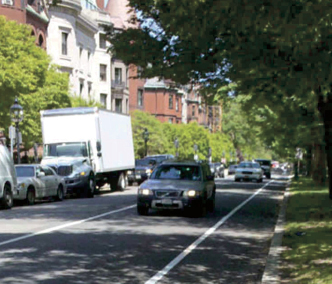
BOSTON, MA
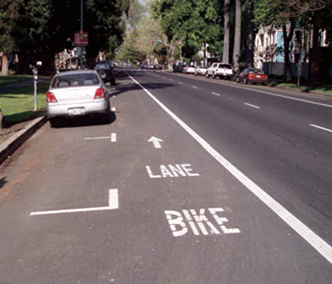
SACRAMENTO, CA

NEW YORK, NY
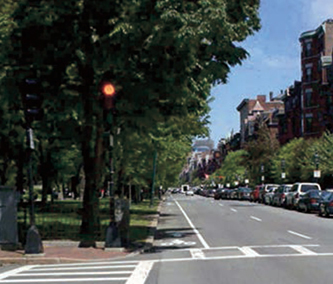
BOSTON, MA
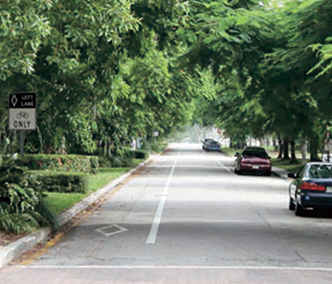
NAPLES, FL (PHOTO: WWW. PEDBIKEIMAGES.ORG, DAN BURDEN)
Maintenance
Like all bicycle lanes, left-side bike lanes should be maintained to be free of potholes, broken glass, and other debris.
If trenching is to be done in the bicycle lane, the entire lane should be trenched so that there is not an uneven surface or longitudinal joints.
Please see guidance for conventional bike lanes.
Treatment Adoption and Professional Consensus
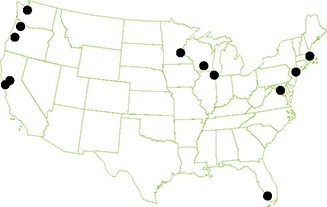
Left-side bike lanes are used in the following US cities:
• Berkeley, CA
• Boston, MA
• Chicago, IL
• Eugene, OR
• Madison, WI
• Minneapolis, MN
• Naples, FL
• New York, NY
• Portland, OR
• Sacramento, CA
• San Francisco, CA
• Seattle, WA
• Washington, DC